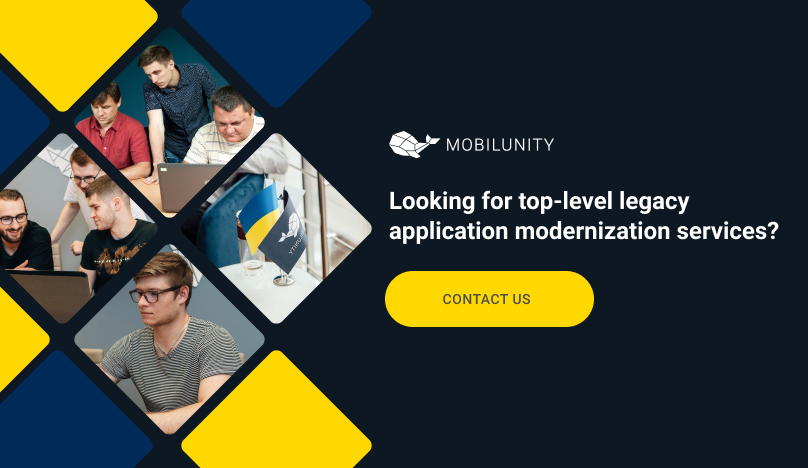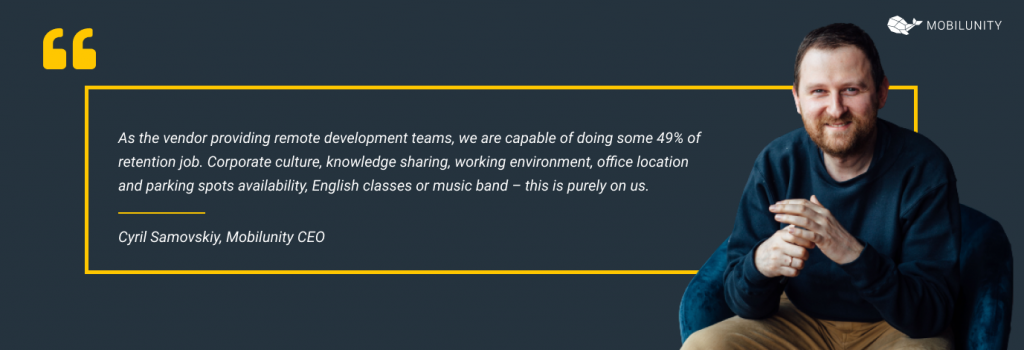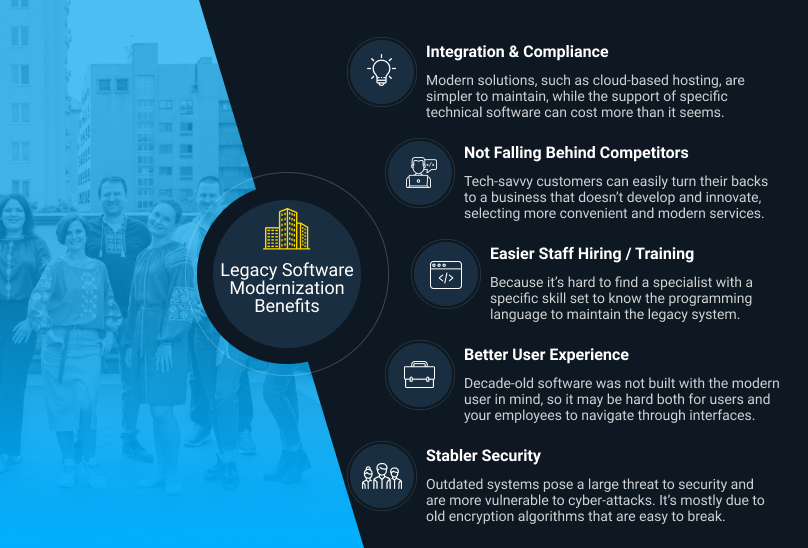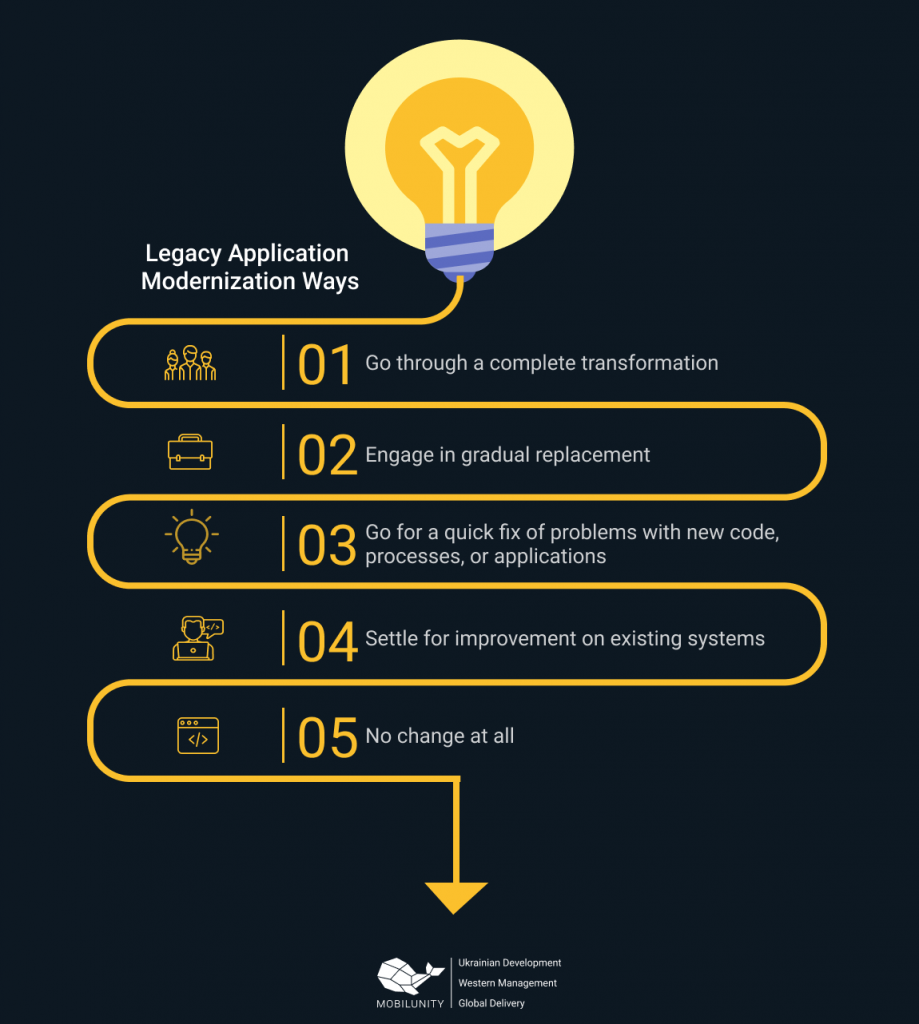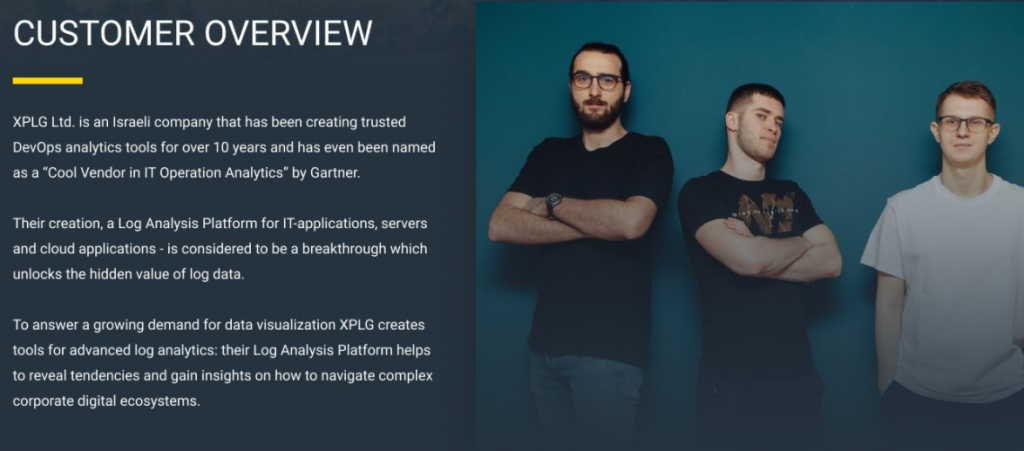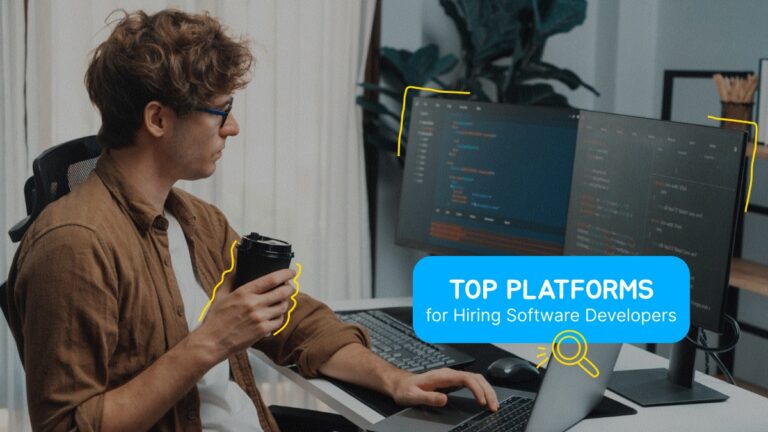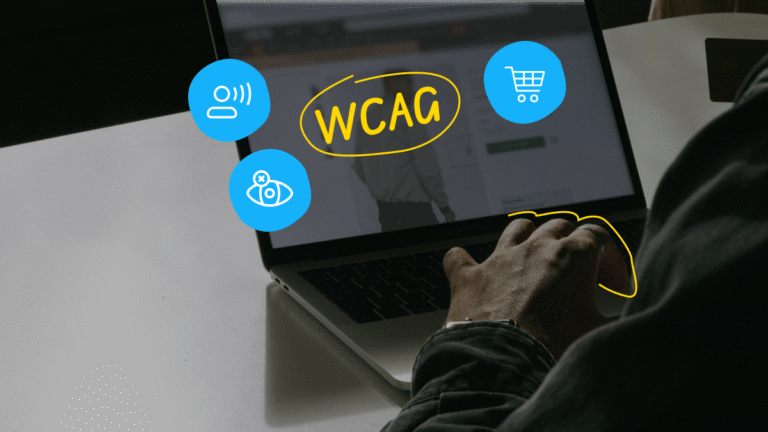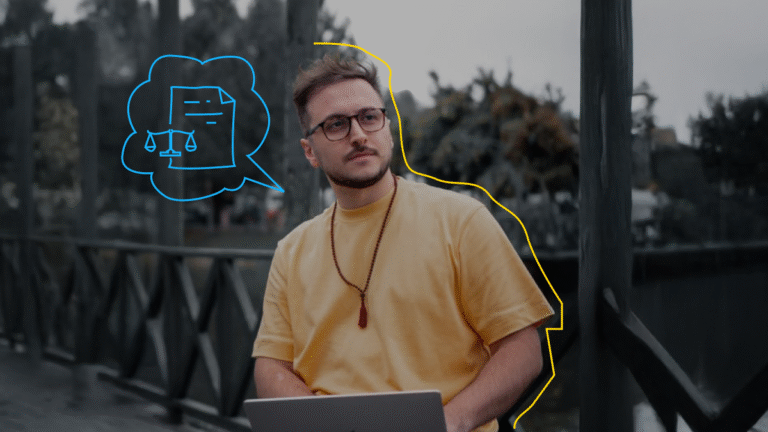Legacy Application Modernization
- Legacy Software in a Nutshell
- Legacy Software Modernization: To Be or Not to Be
- Choosing the Best Option for Your Legacy Application Modernization
- Best Practices On Cutting The Cost Of Software Modernization
- Mobilunity Offers Real Legacy Application Modernization
- Find the Best Solution to Legacy Software Modernization with Mobilunity
- Answering the Most Common Questions Regarding Legacy Systems
Everything in our quick-paced digital world turns old pretty fast. The basic lifespan of the device in today’s world rarely lasts more than 5 years. When new techs emerge yearly, and some tech giants, such as Apple or Google, can stop supporting 5-year old devices, most businesses struggle to keep up with this pace.
While cross-platform support, agility, and scalability are a must for modern solutions, a vast number of businesses still tend to run on outdated software, aka legacy software, for decades. That’s when the legacy system modernization comes to light. In the process of modernizing legacy applications, it is crucial to consider to hire ASP.NET developer and collaborating with HTML5 developers to revamp the user interface and enhance the overall functionality for a more modern and efficient application experience.
Legacy Software in a Nutshell
To put it simply, legacy software is an outdated solution based on outdated tech stack but still used and is crucial for the daily operations of the business. What’s more, legacy software is a real issue for a large number of governmental-level industries, from banking to transportation.
As mentioned in Nextgov, only a few years ago, up to 90 percent of IT budgets were spent on maintaining legacy systems within a number of companies. Nowadays, suppose a company relies on the good old technologies that never failed in the past decade. In that case, it now can be a costly pleasure due to the difficulty of maintaining or updating obsolete software and lead to a sudden and unpleasant crash or system shutdown.
One of such situations recently happened to the US unemployment system. With the sudden unemployment rate jump in 2020-2021 due to the pandemic, the outdated system failed to operate and process thousands of applications. It was mostly caused by the old legacy system that ran over 40 years on COBOL, as well as by the lack of specialists who could maintain and update the software, as reported by The Verge.
It’s not easy to predict when the system can become outdated. It’s usually defined not by the age of the software but by its uprising barrier for transformation or integration with modern solutions. For example, after cloud services came into the IT scene, much self-hosted software needed to be rewritten to keep up with it. In turn, it helped to increase the scalability of projects and made them more flexible.
Trying to continue running the business on an outdated system is like riding the horse on the autobahn – it may bring you to your destination, but it definitely is not worth it. A lot of non-technical companies continue to ride the dead horse, but as long as their software continues to function almost to its full capacity, business owners can deny the need for applications modernization. They simply fail to realize that such neglect for modernization actually equals putting up roadblocks to business development and future prospects.
A number of top world tech companies are continuously working on new updates to optimize their operation and business endeavor. However, legacy architecture modernization is challenging both in terms of budget (as it can have a lot of hidden costs) and programming effort. That is why it’s vital to make a proper assessment of the current legacy system and select the modernization option that will suit the business the best.
Legacy Software Modernization: To Be or Not to Be
While the need to keep pace with updates in the digital world is clear for developers, it’s hard for business owners to settle on the idea that you need to fix the system that still works.
No doubt, the legacy modernization of the system is usually a time-consuming and expensive process. That’s why many companies are hesitant to change something about the existing legacy software. However, such an approach can be more pricey in the long run. So, why would companies spend money and fix a system that is seemingly not broken?
Maintaining outdated software rarely helps businesses to move forward. Any update within the legacy software is risky to perform, and small changes can collapse the entire system or cause some system conflicts. Fixing such issues can be both expensive and time-consuming. Besides, it would be hard to find specialists who can interfere with the source code, so hiring new people may also be a problem. If the system operates on the old language, it can also cause conflicts when integrating it with new platforms needed for further business development.
There are some weighty arguments why it’s beneficial to get to the legacy software modernization as soon as possible. While businesses can think that a budget for modernization seems too high, the expenses for maintaining the outdated software can be comparatively huge.
Besides complex maintenance issues, the most common reasons why the modernization step is smarter budget-wise and future-proof include:
- Integration & compliance. Modern solutions, such as cloud-based hosting, are simpler to maintain, while the support of specific technical software can cost more than it seems. While every industry eventually becomes digitalized, it’s only a matter of time when to move or modernize the software to make it effective for current needs. Besides, the cost of failing to comply with industry specifications can be immense.
- Not falling behind competitors. Nowadays, tech-savvy customers can easily turn their backs to a business that doesn’t develop and innovate, selecting more convenient and modern services.
- Easier staff hiring and training. It’s hard to find a specialist with a specific skill set to know the specific obscene programming language to maintain the legacy system. Thus, it will be hard to replace old experts, and training new workers to use and manage the legacy software will consume more time and money than initially expected.
- Better user experience. Decade-old software was not built with the modern user in mind, so it may be hard both for users and your employees to navigate through interfaces. An attractive and clean design will help enhance the user experience and brand image.
- More valid business opportunities. Legacy software modernization usually means automatization of a large part of the processes that enhances their efficiency and boosts business results.
- Stabler security. As per the Accenture Security Report, outdated systems pose a large threat to security and are more vulnerable to cyber-attacks. It’s mostly due to old encryption algorithms that are easy to break.
To sum up, legacy system modernization is a crucial and unskippable step for any business that aims to reach a competitive edge, have efficient workflows, and boost its profits. It doesn’t necessarily imply the complete rebuild of the system right away. Depending on business needs, there are several options.
Choosing the Best Option for Your Legacy Application Modernization
First of all, it’s better to take a sober look at the legacy software, assess it from a future-proof standpoint. The next step would be picking a modernization option. There are several approaches when it comes to modernization, from full replacement to occasional updates. Sometimes, rehosting or system migration to a new platform is enough, and sometimes, the system needs to be rebuilt in modern language.
After you assess your current software system, you can narrow down your modernization goals and select the approach that will deliver the needed changes to your system most efficiently.
There are two global approaches to how to implement system modernization: revolutionary and evolutionary. Whereas revolutionary (bin-bang) implies a complete replacement of the old system and the construction of a new one, it is a radical way of replacing a legacy system that is not a good fit for every company.
If a company has layers of data that cannot be shifted or moved from an old system without errors, then the only safe method is to gradually replace and improve technologies within the system (evolutionary). This can be both a temporary band-aid method for an outdated system and an optimal solution for businesses that do not need radical changes.
Let’s take a look at the most widespread modernization ways in detail:
- Go through a complete transformation. It usually means complete software reengineering, where you rearchitect the application to adjust it to modern requirements. In this case, the development team defines the legacy system’s main functions, which creates a new product from scratch with the same functionality but better performance. In this case, it’s vital to reconsider and optimize the system’s architecture for future scalability. Any professional team will offer you a microservice architecture approach in this case.
- Engage in gradual replacement.Some platforms don’t require radical methods or cannot be fully undertaken due to their crucial role in daily business needs. In this case, the development team can provide a gradual replacement of the outdated service.
- Go for a quick fix of problems with new code, processes, or applications. Quick corrections within the application are the safest way to ensure your app is modernized swiftly. It usually means re-hosting it to the cloud, database migration, or code-switch (for example, from Angular to React). In other cases, it may mean minor design changes in UX/UI to make the system easier to navigate and more visually pleasing. Such an approach is suitable for systems with complex architecture logic, and the core architecture can be left unchanged.
- Settle for improvement on existing systems. There is no need to change anything in the system core in some cases, as just some adoption of agile software development practices is needed. Thus, if you need to build more functions or scale up the system, you may consider using some existing services, such as SaaS, and cut the cost for modernization of your own application.
- No change at all. Sometimes, there is no need to change the system, and only a close assessment of the existing software can answer.
The best way to modernize the legacy application is to analyze the app’s tech characteristics, move it to the cloud, ROI, and check the compatibility and dependency of the platform on other systems. It helps define what type of implementation of modernization is needed, from a complete transformation of the software system to an easy improvement of the existing system.
Best Practices On Cutting The Cost Of Software Modernization
The decision to modernize legacy software can be hard for many companies due to the high price for this step. In some cases, building the software from scratch is cheaper than re-writing and optimizing the existing system. Estimating the risks and hiring talents to implement the changes can take a lot of time and money.
Thus, it’s smart to also review the ways to cut the modernization costs. There are several ways businesses can save the budget:
- Select a cost-effective region to hire developers.
Given the growing popularity of remote work, it is far less important where the development team is located. Since it can be costly to hire employees in developed countries, companies can expand their talent search to other regions.
This will help you find quality services at an affordable price and thus optimize development costs while maintaining quality. Given the popularity of outsourcing and outstaffing, some countries are already centers of IT outsourcing in their regions. Some of the potential and promising countries with a large pool of IT talents and affordable software development costs are Ukraine, Poland, and Estonia.
- Select a model that requires more engagement but saves budget.
There are a number of ways you can manage your development team. It depends on personal engagement in the process, the control level you want to have over the process, and more. Hiring a team can be challenging in terms of time and money, while the ability to select between various hiring models can open more room for influencing software development costing.
In-house
If you want to directly recruit the team and have developers at hand in the main office, the in-house model is for you. In this way, the company can closely watch the development process, get a quick response on immediate tasks, and secure their data.
On the flip side, the pool of IT talents is limited to the domestic labor market, plus there is quite low flexibility in salaries, and the company will have to deal with all the hiring, managing, and accounting headache.
Nearshoring
The offshoring model is one of the most flexible options for businesses. All issues related to hiring, tech support, office supplements, and team payroll are managed by a service provider. You can hire a team of any scale and manage it most conveniently.
The main challenge is to select a trustworthy service provider, who will take a lot of fuzzy tasks off the business, so you can focus on the project core metrics. Data protection policies are usually discussed and agreed upon in the contract.
Outsourcing
In traditional outsourcing, the company usually delegates some of the responsibilities to the provider company, which provides IT experts for defined tasks and handles office and support issues. Thus, you can get rid of unnecessary worries and will be able to take up the main direction, entrusting all the secondary ones to professionals. The company usually works with a team of existing employees of the service provider, which speeds up the hiring process, but at the same time, the size of the team will be fixed and may be limited to specific knowledge. Besides, data protection upon such cooperation is usually low.
| In-house | Nearshoring / Offshoring / Dedicated Development Teams | Traditional Outsourcing | |
| Team Recruitment | Team recruited directly by the client | 100% dedicated and exclusively recruited team | Team built from the service provider employees |
| Skills and expertise limited by | Domestic labor market | Labor market of the provider’s country | Provider’s staff |
| Who owns and controls the team? | Client | Client | Service provider |
| Team Scalability | Low | High | Low |
| Office and equipment provided by | Client | Service provider | Service provider |
| Team payroll is managed by | Client | Service provider | Service provider |
| Technology selection | Client | Client | Service provider |
| HR management | Client | Service provider | Service provider |
| Project management | Client | Client | Business requirements provided by:- client software requirements provided by:- service provider |
| Data Protection | Full control over the data | Data protection policies implemented by the service provider as per contract | Usually not managed |
| Produced software and intellectual property belongs to | Client | Client | Service provider, unless IP question is covered in the contract |
Mobilunity Offers Real Legacy Application Modernization
One of such successful examples of legacy application modernization is XPLG – a platform that helps visualize business data and perform log analysis.
With the existed back-end (Java) and front-end (Java static web pages) setup, the rendering speed of the platform was lagging. Previously passing data with bits of HTML code, the front-end part of the project was fully migrated to Angular and used Redux store to organize the code. This helped to solve the rendering speed issues and enhance cross-platform compatibility. Thanks to the gradual modernization of the product, the dedicated team provided by Mobilunity was able to preserve service features that were crucial to the project while enhancing performance and improving the visual part of the user interface.
Find the Best Solution to Legacy Software Modernization with Mobilunity
When it comes to outstaffing solutions, it’s vital to find a partner you can fully trust. Mobilunity is a Ukraine-based IT company that has operated on the global market for more than 10 years and knows all the ins and outs of software development. Mobilunity can help you to gather a dedicated team that understands the needs and goals of the business and assist you with a legacy system modernization.
Our clients stress our professionalism and dedicated approach to building a dream team for the business. With the modern approaches and our own time-tested methodology for sourcing the best matching IT talents, Mobilunity experts always go the extra mile to ensure you get the dedicated resources needed within the shortest time possible.
If you are looking for high-end IT specialists experienced in legacy software management and modernization, get in touch with Mobilunity experts and find dedicated developers with the best-matching experience and skillsets.
Answering the Most Common Questions Regarding Legacy Systems
Q: How to choose the right approach to modernizing your legacy systems?
It’s important to make a software assessment before starting to implement any changes to existing legacy systems. It will help to estimate the needed changes, define whether the break-grounding modernization is required, or small updates will suffice.
